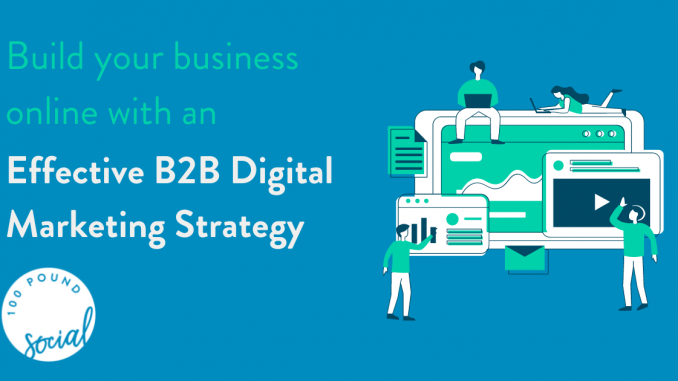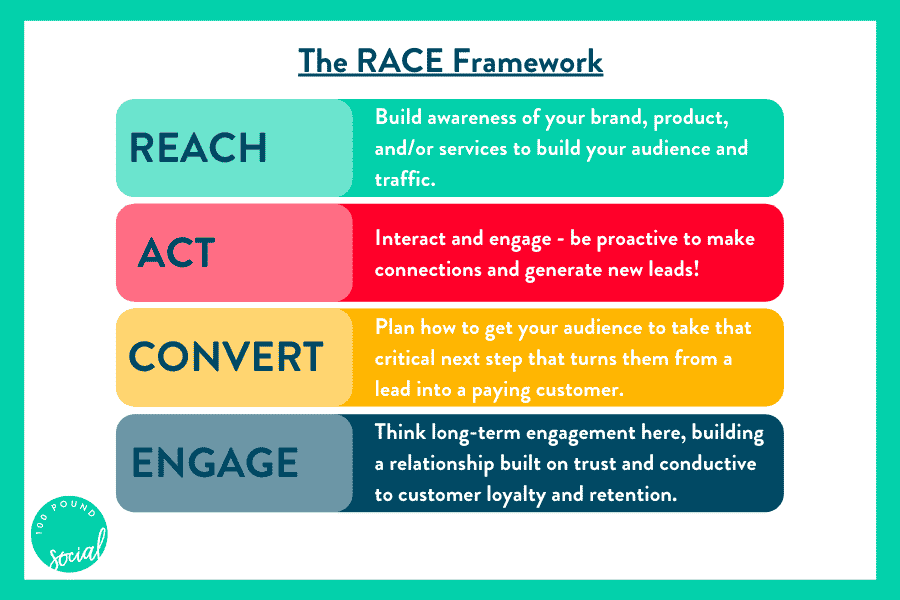
100 Pound Social
Do you have a B2B Digital Marketing Strategy?
A well thought out B2B digital marketing strategy is crucial to growing your business online. It creates a base to adjust plans, measure the success of campaigns, and boost engagements.
Of course, your business needs to succeed on social media and in search engines. But the success rate of an online business depends on more than just social media or search results, and can be improved by the plans you create and execute as part of your strategy.
94.3% of pages get zero traffic from Google. Only 5.7% of newly published pages rank in Google’s top 10 search results within the first year.
However, it is possible to generate a high level of traffic to your B2B business website and close more sales. All you need is an excellent digital marketing plan.
Let’s start by understanding what a B2B digital marketing strategy is.
What is a B2B Digital Marketing Strategy?
A digital marketing strategy is any selling initiative you leverage online to generate leads and close sales. The process focuses on creating conversion-oriented content and outreach.
Aspects of a digital marketing strategy might include:
- Website user experience
- Mobile marketing effectiveness
- Search engine optimisation (SEO)
- Pay-per-click advertisements
- Conversion rate optimisation (CRO)
LinkedIn is 277% more effective than other social platforms for lead generation as part of a digital marketing strategy. This is crucial for B2B businesses.
A successful B2B digital marketing strategy plan needs:
- Timed goals.
- Budget and tools.
- Actionable plans.
- Appropriate channels.
- Roadmap and auditing.
- Helpful and thought-out content.
Let’s now look at simple ways you can boost your business with a digital marketing strategy plan.

Outline your digital marketing strategy SMART goals
Digital marketing strategy goals cover your blog, social media, paid ads, and SEO. Those will be key components to analyse competitors, ROI, and campaign progress.
Your digital marketing goals fall under:
- Short-term: These are goals you want to achieve in days, weeks, or months.
- Medium-term: These are goals you aim to accomplish after a few years of being in business.
- Long-term: These are your ultimate goals after being in business for over five years.
You can focus your goals on generating leads, revenue, engagement, or traffic.
The important part is to develop SMART goals – Specific, Measurable, Achievable, Relevant, and Time-bound.
- Specific: State the exact goal you want. For example, if you aim to increase customers, be clear about the people you will target.
- Measurable: Set the pass mark figure for your goal. This can be quantitative or qualitative. A quantitative goal can be to increase sales by 20% after a year. A qualitative goal can be to increase the perceived quality of the product to attract more buyers.
- Achievable: Let your desired goal be realistic. Do calculations of your business’s spending and revenue before deciding. If you feel stuck, contact an expert digital marketing agency for support.
- Relevant: Note why you want to achieve a particular goal. Doing this will keep your focus on areas that are more impactful to your business.
- Time-bound: Outline the duration you expect it to take to meet the goals. This will help you review your success after the period elapses.
Plan your Digital Marketing Strategy
An excellent online marketing plan should attract prospects, convince, and convert them into customers.
Focus on:
- Identifying the problems.
- Finding solutions to the problems.
- Actioning the solutions to solve the problems.
Note that all businesses are unique and can’t adopt common plans to succeed. Ensure you analyse your firm’s operations and customers before creating a plan. Use the RACE framework approach to funnel your sales – Reach, Act, Convert, Engage.

Reach Out to Prospects
This dictates that you find out which platforms your visitors and prospects frequent. These can be Facebook, Twitter, LinkedIn, Instagram, Pinterest, or Quora, among others.
From there, create posts to generate demand for your product.
Be sure to teach the audience—feed them with facts before promoting your marketing content. You can even offer ‘freebies’ if possible.
It is also useful to invite influencers and followers to share your posts within their network.
Ensure you also practice SEO content marketing tweaks to draw more unique visitors to your content.
Act to Help Prospects Decide
This requires you to start interactions on the preferred platforms to generate leads. Creating readworthy content will be your best approach to boost your conversion rate. It will also increase the time visitors spend on your campaign page, which is good for SEO.
Make your content useful, inspirational, and relevant to attract likes and shares. If you want to run your digital marketing on the site pages, ensure they have outstanding designs. Test their loading time. Boost it to maximum speed to help visitors access your sales pages and buttons faster.
Convert Prospects to Buyers
This will involve reminding and persuading leads to buy your product. Consider retargeting your outreach and re-optimising your conversion rate, whichwill enable you to re-market your product and harness multimedia selling.
Be sure to capitalise on digital marketing tools. Achieving this will enable you to automate prompts and increase sales. It will also reduce order fall-off by creating user-centered content to convince skeptical customers who cancel purchases midway.
Engage with Happy Customers
Over 88% of businesses use social media posts for customer outreach and communications. But 89% of social media messages get ignored. This can be because of the numbers of customers and leads reaching out to ask questions.
To succeed, ensure that you keep customers enthused and satisfied. Define your brand’s voice to make your business identifiable.
Unify content structure on social platforms and web pages. Achieving this is key. It will boost your social media followers and email subscribers, and increase your chances of gaining repeat customers.
Analyse your Business using the SWOT Framework
A SWOT framework provides information to tailor and improve business performance. The process isolates and highlights the relevancy of challenges. It also devises workable solutions.
The SWOT framework adopts two parts—internal and external:
Internal Assessment
Strengths: Check and list everything that contributes to your business’s success. This may include:
- Strong R&D.
- Strong engineering
- Good sales network.
- High-quality products and services.
Weaknesses: Analyse aspects that reduce business productivity and ability to thrive. These may include:
- Long lead times.
- High manufacturing costs.
- Slow response to customers.
- Slow response to market trends.
External Assessments
Opportunities: Find avenues that are ideal for helping your business to prosper. These may include:
- Market growth.
- Friendlier government policies.
- R&D projects required.
- Customised products needed by the market.
Threats: Check setbacks that put your business on the verge of failing. These may include:
- Increased competition.
- Overseas competition.
- Competitors’ new ideas.
- New technologies making products obsolete.
Each of the assessments should contain quantifiable information. That will help you collect details on the emerging challenges.
Pitch your Digital Marketing Strategy
Different digital marketing tips and channels require different approaches. But the strategy and campaign you use depend on the platform you pick and who you are targeting.
For example, reading an eCommerce study can help you boost traffic and inquiries if you are in the eCommerce industry. You can even skim through a couple of digital marketing strategy examples to get ideas.
The trick is being honest with your assessment. Don’t overlook your business’s weaknesses.
Instead:
Create Buyer Personas
A buyer persona involves a set of information about your customers.
A useful way to go about building a buyer persona is to research and segment your target audience and market. You can conduct surveys or interviews to collect the information. Building comprehensive buyer personas will inform you on how best to tailor your content and campaigns.
Creating personas requires the use of different information segments:
| Geographical | Demographic | Behavioural | Psychographic |
| Country Region Climate City Urban/rural area |
Age Education Gender Religion Income Race Job title Language |
Challenges Hobbies Goals Purchasing style Budget Activities Media consumption |
Social Culture Values Priorities |
After segmenting your audience, your personas should have five facets:
- Background: Behaviour, geographics, demographics, and psychology.
- Problems: Identify the challenges you wish to help your audience solve.
- Benefits: Note down the benefits your audience stands to gain.
- Goals: Determine what will drive your audience to buy your product.
- Objectives: Create answers to the questions your audience may have before buying.
Position your Campaign
There are many avenues you can use to market your product. But all have different audiences and competition levels.
As you may now know, LinkedIn is the most effective B2b marketing tool. You only need an outstanding digital marketing strategy for social media to position a campaign on it.
Be sure to pinpoint your unique selling propositions (USPs)
- Put yourself in the customers’ shoes. Scrutinise the product they want, how they want it, and how much they are willing to part with to get it.
- Find out what motivates your customers’ decision-making process. Make sure you go beyond looking at their geographical, behavioural, and psychographic aspects.
- Find out why customers would prefer buying from you and not your competitors. You can achieve this by conducting a survey.
Organise your Content
Your digital marketing content falls into the following categories:
- Owned media: Blog SEO content, social media profile, and website.
- Paid media: Paid social media posts, sponsored posts, Google AdWords.
- Earned media: Guest posts, PR work, influenced outreach, and social media shares.
- Customer experience media: Homepage, user-generated content, product page, and CRO.
The success of any of them dictates the next move you will need to market your business.
Create a Stellar Digital Marketing Strategy Plan for your Content
Excellent videos, images, writings, and audios are the cornerstone of any digital marketing strategy.
Prospects want to read about a product’s content that resonates with them before buying. Over 73% of successful B2B businesses use content marketing to nurture leads, audience and subscribers. Ensure you make posts relevant. That way, your customers will be eager to hear from you and won’t send your reach-out emails to the spam folder.
Writing blog posts is a top inbound marketing strategy. It is a sure way to engage with your audience and expand your digital customer base. It helps to generate organic traffic campaigns and reinforce your social media pages.
The secret to a successful blogging process is to conduct thorough keyword research. Be sure to build lots of internal links and write informative posts often. That way, you will boost your sales pages ranking position through SEO.
If you cannot write well or do keyword research, seek help from an expert digital marketing agency.

Supercharge your Digital Marketing Strategy
Your marketing strategy needs a boost to keep up with the competition. Reading digital marketing strategy examples alone can’t revamp your business. You need to harness extra digital marketing tips to stay ahead of the competition.
Audit your Owned Media Content and Campaigns
You will, from time to time, need to assess your digital marketing strategy trends. Check social, political, and economic factors that influence your success or failure. Doing this will steer you to addressing problems on time and staying up to speed with customers’ needs.
Owned media forms the heart of your digital marketing auditing process. This means you analyse your video marketing content, SEO blog articles, marketing podcasts, and social media posts.
| Type | Metrics |
| Web pages | List of URLs, duplicate pages, sitemaps, page titles and descriptions. |
| Content | Social shares, backlinks, content titles and descriptions, content length. |
Use Predictive Analytics
Predictive analytics are effective in measuring your return on investment (ROI). They also help devise effective ways to boost sales.
Google Ads and Facebook Ads command over 50% share of total digital advertisements. Use them to guide your predictive analytics.
The data you collect will tell you more about your prospects’ behaviours. Use it to your advantage and identify leads. Be sure to understand their problems.
Utilise Digital Marketing Tools and MarTech
The use of Marketing Technology (MarTech) in organisations has increased by 150% since 2020. This is a clear sign that MarTech and tools form an integral aspect of digital marketing. They automate repetitive tasks, allowing you to attend to other complex business activities.
MarTech software helps in customer relationship management (CRM), which increases your chances of winning repeated sales and referrals.
Integrating digital marketing tools and MarTech software has many benefits. These tools allow you to:
- Tweak SEO.
- Funnel leads.
- Conduct surveys.
- Align landing pages.
- Design campaigns.
- Manage social media.
- Manage your email list.
- Assess the progress of campaigns.
- Run customer loyalty programs.
- Manage content marketing systems (CMS).
Note that digital marketing tools are not flawless. Some can be badly executed, need human monitoring, and can ruin the performance of your campaigns.
Getting digital marketing training or reaching out to an expert digital marketing agency will help you generate leads and put your sales funnel on autopilot.
One downside of marketing training is that you might spend a lot of money and time before becoming a pro at marketing podcasts, videos, or even written content.
Increase Customer Trust
Acquired customers are a good option to scale your business. They form a crucial referral channel to sell to prospects and referrals.
The best way to win your customers’ trust is to nurture seller-buyer relationships. Know the type of posts to use on your social media pages to boost engagements and promote your brand.
Establish KPIs
Key performance indicators (KPIs) are your best option to achieve your content and video marketing goals.
KPIs show your achievement milestones in mobile marketing SEO, revenue, social media metrics, and much more. A rule of thumb is that you set only a few goals to avoid a crammed digital marketing strategy that is too complex to provide actionable insights.

Leverage the skills of an Expert Digital Marketing Agency
Hard work is vital to building a successful digital marketing strategy plan for your business online. But competition for online customers is fierce.
You need SEO-optimised blog articles from the get-go. You again need workable tactics to generate leads, manage digital campaigns and assess KPIs. Segmenting and targeting your campaigns is crucial for your digital marketing strategy plan.
As you can see, you need resources, time, and skills to succeed. But don’t worry, our expert team at 100 Pound Social helps hundreds of businesses break through their competition.
| Service | Specifications |
| Blog Articles | A dedicated UK-based Content Creator & Editor.5 working-day delivery, including revision.2-8 articles of up to 4000 words per month. |
| LinkedIn Lead Generation | A dedicated LinkedIn Manager.Target 100 prospects per week via LinkedIn.A 3-part messaging campaign to send to your LinkedIn prospects. |
| Social media posts | A dedicated UK-based Content Creator & Editor.3 handcrafted posts per week published to 2 platforms.A dedicated Customer Success Manager. |
| Add-ons to post/LinkedIn plan | Blog articles of up to 4000 words.5 or 7 extra social media posts per week.Posts published to additional social media platforms, including Instagram.Content Panel — preview your scheduled posts in an editable content calendar. |
Our professionals at 100 Pound Social consist of knowledgeable, UK-based writers, social media managers, LinkedIn managers, and editors for B2B and B2C industry niches.

Become a better social marketer.
Get expert social media advice delivered straight to your inbox.
The post Build Your Business Online with an Effective B2B Digital Marketing Strategy appeared first on 100 Pound Social. Read more at 100poundsocial.com

Leave a Reply